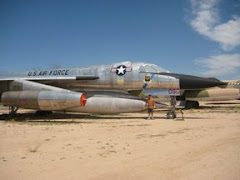The State of Washington has a long history tied to aircraft. In WWI, Washington spruce wood was used in many an airplane. In WWII, Washington had the cheap power needed to process and smelt aluminum. The Boeing company began its life here. During WWII numerous local airfields were home to Army Air Corps training bases.
Washington is/was also home to Microsoft...Paul Allen, one of the duo who founded Microsoft, despite having obscene amounts of money, has a very real and admirable interest in aviation. His generosity is shown in the sharing of his growing collection with the public. It is greatly appreciated. His museum is the Flying Heritage Collection, in Everett, Washington.
This collection is full of rare and prized WWII aircraft. Each of the great powers is represented.
England:
Spitfire
Hurricane
Avro Lancaster (Nose)
USA:
P-40
P-47
P-51
F6F
JN4 Jenny (WWI)
Japan:
A6M Zero
Ki-43 Oscar
Germany:
Me-109
Me-163
FW-190
Feisler Storch
Buzz Bomb (V-2)
Manned Buzz Bomb
2X Flak guns! (88mm)
Soviet Union:
IL-16
PO-2
All in all, it is a great collection. The Me-163 is worth the small price of admission, which is only $12.00. (I feel like I am really talking this place up, and I want to find something wrong with it...nah, I can't really find anything wrong with it.)

Messerschmidt Me-109

Genera view of collection below.

Grumman F6F below

The Japanese Army did not use the A6M Zero, they used a similarly light and agile aircraft, the Ki-43 "Oscar."

The nose section of an Avro Lancaster, called the Lanc by its crews.

The minuscule Me-163 Komet, a rocket powered aircraft with an eight minute powered flight time. It was the fastest operational aircraft in WWII. As for the small propeller, I have been told, somewhere in the distant past, that it was used to drive the generator for electrical power.

The wheeled dolly dropped off as soon as it was airborne, it landed on the skid on its belly.

Below are both of the V-2s.

The Japanese Navy used the A6M to great advantage in the first few years of the war, but the Americans soon discovered its weaknesses. Below we have one of the few surviving examples...still undergoing restoration by the look of it.

This is another prize of the collection (the other is the Me-163, in my humble opinion), a Focke Wolfe Fw-190! Long nose.

The newest arrivals: Flak guns!! The German 88 bomber crews SO hated.

Another photo of the Me-109.

The nose of the P-40. (I gotta say, I like this photo)

The Hawker Hurricane.

The little Soviet fighter that could, the Il-16.

The Spit. Check out that Rolls Royce!

Yet, another photo of the Me-109!

The P-51.


The P-47...is the sleekness of the P-51 obvious here?

Look at all the places a P-47 can leak...I don't care how fast the P-51 could go, the old Jug is still my favorite. I think it might be the fact that it carried eight (8) .50 caliber machine guns...the P-51 only carried six...


After the Flying Heritage Museum we drove up to the Boeing Restoration Center. It is a really laid back facility. Tools and aircraft parts were everywhere. This is a working facility here but I could have spent hours there just ogling the pieces of history all over the shelves! Have a look.


Below is a very rare jet indeed! A Vought F7U Cutlass...better known to her pilots as the Gutless.

below is an Antonov An-2 Colt.

In one hangar there were just engines on shelves...tons of engines!

Another view of the F7U.

And the Feiser Storch of the FHC! It took off in less than 200 feet, and landed in roughly the same distance...or less.

There are a few more museums in Washington, I hope to post on all of them eventually.
Also at Paine Field is the Storm Birds Hangar where they are building NEW Me-262s!






















